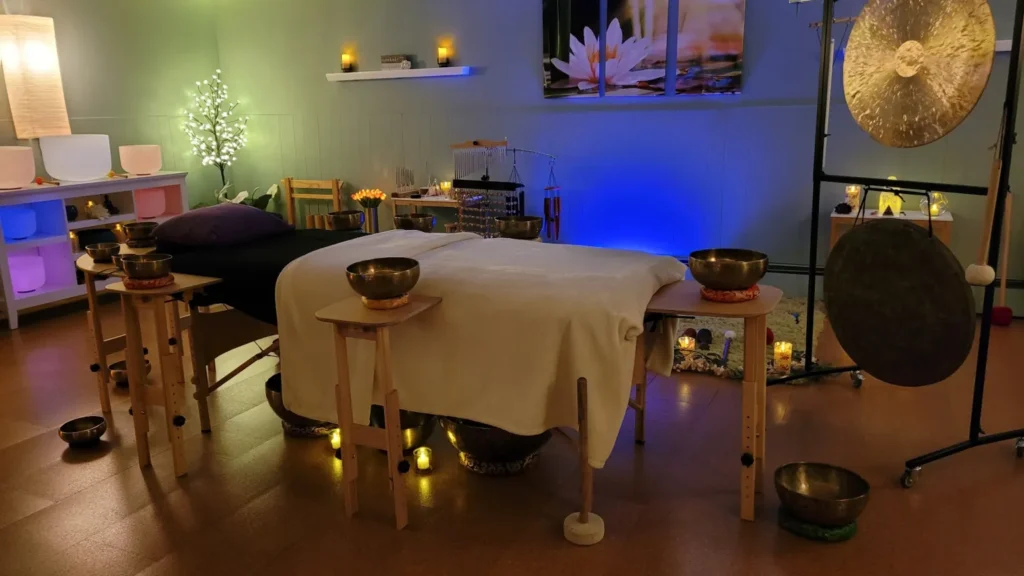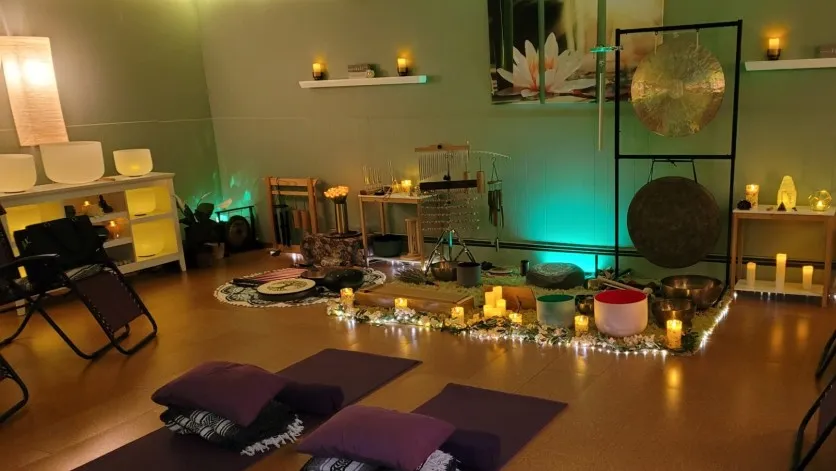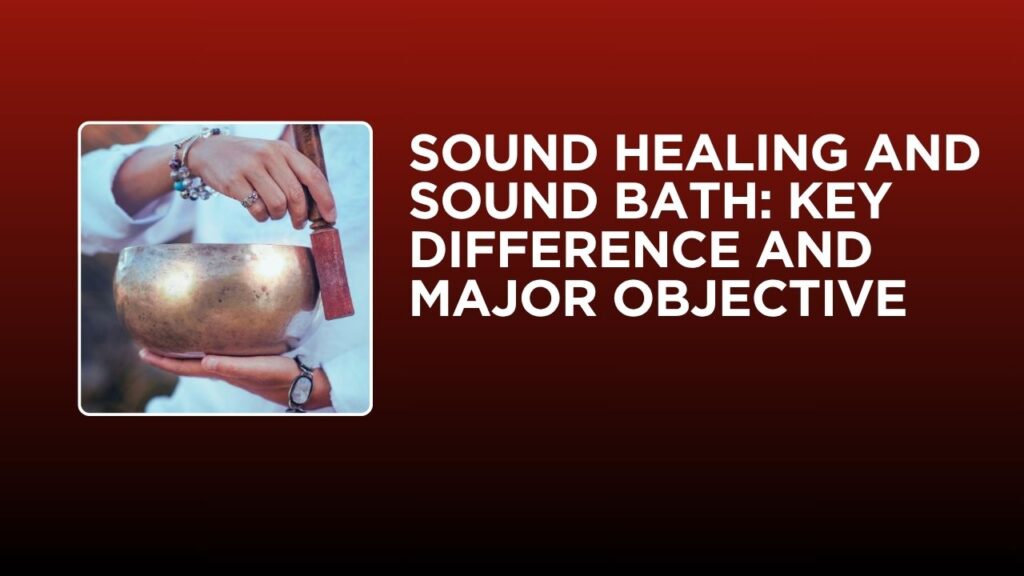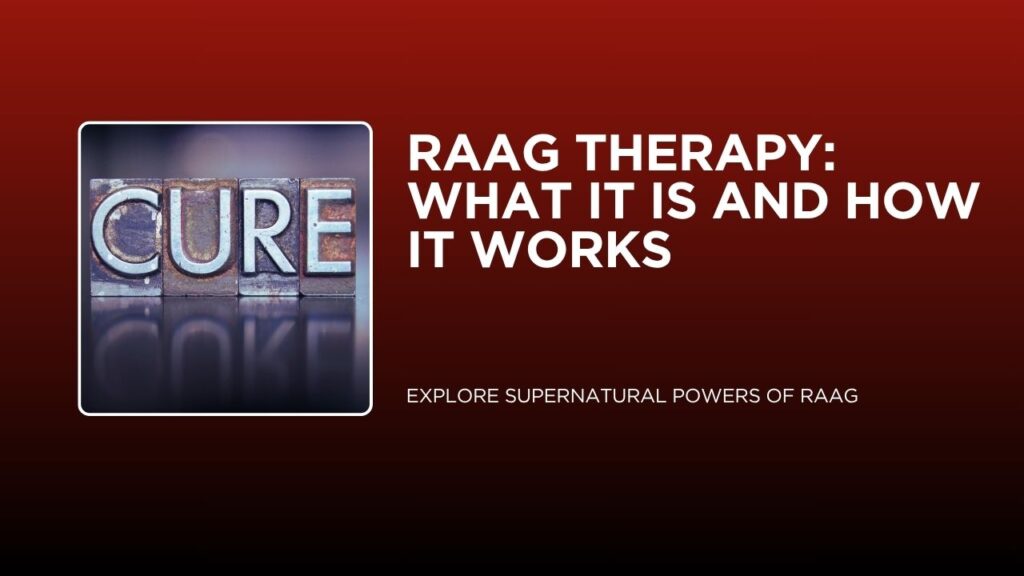Introduction
The practices of sound healing and sound bath have gained immense popularity among wellness seekers across the world. These powerful techniques, rooted in ancient traditions, are now recognized as effective methods for stress relief, emotional balance, and deep relaxation. But while they’re often mentioned together, sound healing and sound bath are not exactly the same. In this blog, we explore the major objectives of each practice, their core differences, and how they can contribute to holistic well-being.
Sound healing and sound baths are therapeutic practices using sound vibrations to promote relaxation and well-being. Sound baths are a type of sound healing, often described as a deeply immersive, full-body listening experience. While both involve using instruments like singing bowls and gongs, sound healing can be more focused on addressing specific health or emotional issues, whereas sound baths are generally used for relaxation and stress reduction.
Though a sound bath may seem like a “new age” concept, the practice of healing bodies through sound is technically thousands of years old with deep roots in cultures across the world. A sound bath is a meditative experience where those in attendance are “bathed” in sound waves. These waves are produced by various sources, including healing instruments such as gongs, singing bowls, percussion, chimes, rattles, tuning forks, and even the human voice itself.
This “spiritual, cleansing music” varies according to place and culture, but it can be as simple as chanting an om following your yoga session or as complex as an hour-long experience in a dedicated space with a sound practitioner.
The music doesn’t have a catchy melody or rhythm like you’d experience at a rock concert or symphony. Instead, it’s a carefully selected wash of instrument and voice with notable resonance and overtones.
Sound Healing
Sound healing is a therapeutic practice that uses specific sound frequencies, instruments, and vocal techniques to promote healing on physical, emotional, and energetic levels. This form of healing is often conducted by trained practitioners who use various tools such as:
- Use of Raag as the primary Raga Therapy
- Voice (mantras or overtone chanting)
- Singing bowls (Tibetan or crystal)
- Tuning forks
- Gongs
- Chimes
The primary objective of sound healing is to restore the body’s natural frequency, reduce energetic blockages, and activate the parasympathetic nervous system. By targeting specific vibrations, sound healers aim to harmonize imbalances within the body and mind.It is a more targeted approach that involves the application of sound frequencies to the body and mind with the intention of promoting healing and well-being.
During a sound healing session, the client is typically on a massage table surrounded by Tibetan singing bowls, with additional bowls placed underneath. Bowls are floated above and around the body, and at the client’s request, bowls and other instruments can be played directly on the body to enhance the therapeutic effects. The practitioner will choose from a plethora of sound healing instruments to achieve the intended goal.

Key Features of Sound Healing:
Interactive Techniques: The practitioner may use in addition to singing bowls and other instruments, more specific tools like tuning forks or vocal toning, to interact directly with the client’s energy field.
Active Participation: The practitioner may work directly with the individual, using instruments or vocal tones close to or on the body.
Targeted Therapy: The sessions can be customized to address specific issues such as pain relief, emotional release, or energy and chakra balancing.
Vibrational Frequencies: Different frequencies and instruments are chosen based on the therapeutic goals.
Individual Focus: While sound healing can be done in groups in a minimal form, it often involves one-on-one sessions tailored to the individual’s needs.
Sound Healing as the form of raga:Classical music
Music is found to be a prime influencer of the cognitive functions in human beings. A regular dose of music helps in the smooth functioning of neurons and synapses in the brain. Neurological studies have shown that music is an effective tool to improve the functions of the brain. The different parts of the brain involved in processing music include the auditory cortex, frontal cortex, cerebral cortex and the motor cortex.
The indigenous medical science, known as Ayurveda, has a branch called ‘raga chikitsa’ that deals with the application of music for curing illness. Indian classical music is capable of evoking specific feelings and moods within the listener, a quality which makes it effective for therapeutic application.
In Indian music, raga is a unique set of chosen notes around which improvisation is done by practitioners. A particular raga can have different effects. Each raga has a certain ‘rasa’ or mood which causes the listener to imbibe a specific feeling. The effect of raga is captured by the frequencies of the notes that compose the raga. Indian ragas are suitable for emotional healing in cases of anxiety and stress and induce a state of meditativeness and calmness.
The aspect of meditation is ingrained in Indian classical music. The highest and the most subtle form of music is supposed to transcend the listener to the state of ‘samadhi’ in meditation. The virtue of a classical raga has been judged on its ability to transcend the listener to the meditative state. The traditional style of ‘Dhrupad’ had this meditative quality in abundance, but the developed style, later called ‘Khayal’, has modified the style to some context.
Though these two styles are more in vogue, another style of presentation that has been popularised is called ‘music meditation’, where music is played without any rhythmic accompaniment and in a slow tempo to elaborate the meditational quality. Spiritual organisations have used it widely to aid spiritual practices as well as in the home atmosphere. Performers who have specialised in this genre of music are highly sought-after and it has been established as an alternative style of rendering classical music.
When music is used as an aid to meditation, it can enhance the results by bringing stress relief faster. For all kinds of music aficionados, music meditation comes as a more approachable technique than other forms of meditation practices.
A conscious focus on the music helps us prevent in our minds from drifting away whenever stray thoughts, feeling, or ideas come along. Constantly dwelling on the music creates a soothing effect on our body, mind and heart, bringing relaxation and awareness.For more details. You can reach
Romance Of The Ragas
According to Indian classical music maestros, ragas have enormous power to influence emotions in human beings by tapping into the reverberation fo the human body. The mood depicted through a raga is related to its pitches and their relations with one another. Certain pitch classes commonly occur in ragas conveying a particular kind of emotion. The pitch set of a raga and its characteristic phrase establishes the flavour or mood of the raga. Ragas are classified according to the most appropriate time of day to be played and to the predominant rasa or emotion that they evoke. Each different raga holds its own set of rules upon which the melody relies and respects.
Some ragas like Darbari Kanada, Khamaj and Pooriya are helpful in defusing mental tension, particularly in the case of hysteria. Raga Malhar is found to pacify anger, excessive mental, excitement and mental instability, whereas raga Jaijaivanti has also been found effective in curing mental disorders and calming the mind.
Indian music has a unique method of setting definite times of the day and night for performing ragas. The performance of the ragas at a definite time of the day or night manipulates the daily cycle of changes that occur in our moods and emotions at different moments of the day. Ragas are supposed to show the highest aesthetic splendour at the particularly allotted hours. While some ragas are found to be very appealing in the early hours of the morning, others are more attractive in the evenings, and yet others appeal more to the senses at the midnight hour.
Then there are ragas presenting their supreme splendour in the rainy season (such as raga Megh and raga Malhar), the autumn season (such as raga Basant), and the spring season (such as raga Bahar.) Seasonal ragas can be sung and played any time of the day and night during the season allotted to them. The mental and emotional responses in the autumn or winter or during the rainy season are different from the spring. Scheduling playing times of ragas has a variety of advantages. It fits the mood of the raga with our mood, thus forming a fusion of body and soul.
Each raga is associated with a definite mood or sentiment that nature arouses in human beings. The ancient musicologists were particularly interested in the effects of musical notes, and how they affected and enhanced human behaviours. Music had the power to cure, to make you feel happy, sad, disgusted and son on. Each raga in Indian classical music, conventionally assigned to a corresponding rasa / emotion is known to consistently evoke a certain emotion. The artist exploits her creativity and elaborates a melodic framework to bring out the rasa or the emotion.
Raga therapy should be used more widely for its therapeutic benefits since current society needs relieving stress in day-to-day life. There is a need for more research in this field and organising more and more workshops in every part of the world.
SOUND Bath

A sound bath is a meditative experience where participants “bathe” in the sound waves produced by various instruments such as gongs, Tibetan singing bowls, crystal bowls, chimes, and other resonant instruments. The primary purpose of a sound bath is to promote deep relaxation, stress relief, and a meditative state.
A sound bath is a meditative, immersive experience in which participants are “bathed” in sound waves created by instruments such as gongs, crystal bowls, and chimes. Unlike sound healing, a sound bath is not typically focused on a specific ailment or condition but rather provides a relaxing and calming atmosphere to experience inner peace.
During a sound bath, participants usually lie down in a comfortable space with their eyes closed while the practitioner creates a soundscape. The objective is to allow the listener’s mind to enter deeper brainwave states, such as theta and delta, which are associated with deep meditation, creativity, and rest.
“The intention is really to change and help balance the energy of the participants. During a sound bath, you don’t want to hook into a melody. You don’t want to repeat things because you don’t want the brain to recognize a repeated beat. Instead, you want participants to release, and you want the brain to let go.”
-Tamalyn Miller, Lead Sound Practitioner ar Naturopathica Chelsea
Key Features of a Sound Bath:
- Passive Experience: Participants typically lie down on a comfortable mat or recline in a relaxed position.
- Immersive Sound: The practitioner plays the instruments in a continuous flow, creating an enveloping soundscape.
- Relaxation and Meditation: The goal is to help participants enter a meditative state and experience deep relaxation.
- Group Setting: Sound baths are often conducted in groups, though private group sessions are also available.
- No Direct Interaction: The practitioner does not usually interact directly with each participant individually, but it may occur briefly.
Benefits of sound baths
Scientists have long studied the health benefits of music. For example, a 2014 systematic review of research studies found that music was a “safe” and “inexpensive” supplemental therapy that helped with pain control.
But there isn’t much research into the science behind sound baths. A 2020 systematic review of four peer-reviewed studies (including one involving people living with metastatic cancer and another with chronic spinal pain) showed possible health benefits after playing or listening to singing bowls. However, the review concluded that more evidence-based research and studies are needed in this area.
Anecdotally, however, Bond says it’s common to feel different after having a sound bath meditation. Things you might experience include:
- Feeling calmer/less stressed.
- Muscles that feel looser.
- A greater sense of relaxation.
- Pain relief.
- The ability to sleep better.
- Improved mood.
- Better body awareness/being more in tune with your body.
A sound bath shouldn’t be considered a replacement for any medical treatments you’re having. Instead, it’s better seen as a complementary or supplementary treatment. “Many things out there aren’t in opposition with any treatments we might be receiving from our doctors,” Bond says. “It’s useful to remember that there are complementary therapies available, like a sound bath, meditation, yoga and tai chi.”
Are there different sounds in a sound bath?
A sound bath practitioner doesn’t necessarily need to be a musician. But Bond says they do go through a certification process with formal training to become one, much like a yoga teacher does.
Types of instruments used in sound baths might include:
- A gong.
- Crystal singing bowls.
- Metal bowls.
- Tibetan singing bowls.
- Tuning forks.
- Chimes.
Bond also says it’s possible to use a digital recording for a sound bath. “However, the best way to do one is in person because your whole body gets to feel the vibration.”
Side effects of sound baths
Sound baths affect every person differently. “Some people may feel tired after their sound bath, and some people may feel the opposite — they may feel energized,” Bond notes. “It just depends on the person’s individual concerns and what transformation was made during the session.”
Bond does advise that you should drink plenty of water, eat healthy food and get a good night’s sleep before having a sound bath. “Eat lightly before a sound bath and make sure you’re well hydrated because a sound bath tends to work better,” she explains.
Bond cautions that if you’re living with a psychiatric disorder, you should check with your doctor first to see if having a sound bath is OK.
“It’s essentially the same rules as for meditation,” she states. “If you have a serious psychiatric disorder like schizophrenia and want to start a meditation practice, talk to your doctor first. In some people, meditation can cause or heighten some symptoms of those disorders.”
What to expect at a sound bath
The length of sound baths varies, and Bond says there’s no optimum duration to get the most benefits. “It’s like meditation,” she notes. “That can also go for any length of time, and it’s beneficial at any duration. With the longer sound bath sessions, you can go a lot deeper into relaxation. But shorter sessions are effective, too.”
Bond suggests wearing loose-fitting clothing to a sound bath, as being comfortable is key. “If you tend to run cold, make sure you bring a blanket because you don’t want to be distracted by feeling too cold,” she continues. “If you tend to run warm, make sure you’re dressed in loose clothing.”
Usually, people will lie down on the floor to have a sound bath, although sitting in a chair is also an option. “The idea is for your body to be in a relaxed state where there isn’t any physical tension, or effort,” Bond says. “If you’re lying on a yoga mat, put something underneath your head or under your knees if you have back problems. Whatever it takes to have a comfortable position for your body.”
| Aspect | Sound Healing | Sound Bath |
|---|---|---|
| Objective | Targeted healing and energy balancing | Deep relaxation and meditative immersion |
| Approach | Individual-focused or small groups | Group session or large audience |
| Technique | Uses diagnostic intuition and tuning | Uses layered soundscapes and improvisation |
| Practitioner Role | Active engagement with the client | Passive guidance through sound |
| Intensity | Can be intense and transformative | Gentle, immersive, and calming |
Which One is Right for You?
Choosing between sound healing and sound bath depends on your needs:
- If you’re seeking deep emotional release, physical healing, or spiritual alignment, a sound healing session might be best.
- If you’re looking to unwind, meditate, or release mental tension, attending a sound bath can be incredibly rejuvenating.
Many wellness centers and spiritual retreats offer both experiences, sometimes in combination. Manasukh Dhvani, for example, provides guided sound healing and sound bath sessions in Nepal, led by experienced practitioners trained in classical Indian traditions, Dhrupad, and meditative sound practices.
Conclusion: Embracing the Power of Sound
In today’s fast-paced and overstimulated world, sound healing and sound bath offer a sanctuary—a chance to return to stillness and resonance. While sound healing dives deep into the root of energetic or emotional disturbances, sound baths provide a more expansive, passive experience for rest and spiritual connection.
Whether you are new to these practices or already a passionate seeker, integrating sound healing and sound bath into your wellness journey can lead to profound shifts in awareness, vitality, and peace.




Pingback: What is the Sonic Alignment Technique? A Practise to align mind and body - Manasukh Dhvani